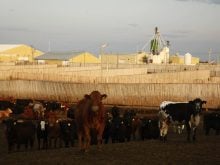This cattle market information is selected from the weekly report from Canfax, a division of the Canadian Cattlemen’s Association. More market information, analysis and statistics are available by becoming a Canfax subscriber by calling 403-275-5110 or at www.canfax.ca.
Fed rally ends
Average prices were generally $1-$2 per hundredweight lower last week on a light to moderate volume of Alberta direct cattle sales. Most sales were dressed from $252-$253 per cwt. delivered.
Read Also

Huge Black Sea flax crop to provide stiff competition
Russia and Kazakhstan harvested huge flax crops and will be providing stiff competition in China and the EU.
Following a five-week price rally, packers tightened bids and feedlot managers last week were not motivated sellers. As a result, a significant portion of last week’s fed offering was carried over.
Western Canadian fed slaughter for the week ending Oct. 13 eased 13 percent lower than the previous week to 35,853 head. Year to date, western fed slaughter is six percent larger at 1,540,978 head.
Canadian steer carcass weights for the same week eased seven pounds smaller than the previous week and two lb. larger than last year at 924 lb. Canadian fed-cow exports to the United States for the week ending Oct. 6 were nine percent larger than the previous week at 9,685 head and year to date totalled 289,161 head.
In the Canadian outlook, Canfax said carcass weights typically peak during the second half of October, and feedlots are still working through some heavy cattle. Ample market-ready supplies are anticipated, and feedlots need to move fed cattle to free up space for fall calves. Buyers will maintain leverage through October, but export and holiday demand will support prices.
In the U.S., last week saw light trade and prices mostly steady with the previous week from US$110.50-$111 per cwt. Dressed prices in the north were steady to $1 per cwt. higher than the previous week, from $173-$175.
New low for cows
Butcher cows established new lows last week, trading C$1-$1.50 per cwt. lower.
D2 cows traded at $75-$92 per cwt., to average $83.07. D3s traded at $65-$80 to average $71.60.
From their second half highs in June, butcher bull prices have dropped 18 percent.
Over the past 10 years, the average decline from first half highs to lows stands at 21 percent. Further price risk is possible because butcher bull prices traditionally don’t bottom until late November or early December.
Western Canadian cow slaughter volumes totalled 5,658 head, and for the first time since June, cow slaughter volumes were below year-ago levels.
Given tighter feed stocks and less than ideal grazing conditions this summer, one could argue non-fed cattle have been marketed ahead of schedule. Larger non-fed supplies are still expected, but slaughter volumes may struggle to keep pace with last year.
Calf prices lower
Last week was tough for the calf market. Prices were $5-$10 per cwt. softer. Technically the calf market was well supported because deferred live cattle contracts were down less than 100 points from Friday to Friday. Weakness on the calf market was more related to large volumes of calves trading across Western Canada.
Heifer calves weighing 500 to 600 lb. established new second half lows. Heifers weighing 550 lb. were trading slightly more than $30 per cwt. back of their steer counterparts, which was the widest steer-heifer price spread since the middle of May.
The largest year over year price decline on 550 lb. steers was reported in Alberta (down $13 per cwt.) while the smallest year over year decline was reported in Manitoba (down $9 per cwt.)
Over the past three weeks, 550 lb. steer prices in Manitoba have been at a premium to both Alberta and Saskatchewan markets. Demand for yearlings continues to be strong as prices trade within $2-$3 per cwt. of their annual highs.
Calculations on the feeder index indicate Canadian feeder prices remain at a premium to the U.S.
In the outlook, considering the most recent live cattle import data, U.S. feeder imports into Canada for the month of August totalled 13,964 heard compared to 2,772 head last year. Calf volumes are expected to increase over the next couple of weeks, and calf prices are expected to be steady to lower.
Beef trade improves
In U.S. beef trade, values firmed higher last week on light to moderate demand and offerings. Choice averaged US$206.82, up about $4 from the previous week. Select averaged $192.35, close to the previous week’s average of $192.49.
Canadian cut-out values for the week ending Oct. 12 saw AAA trend sideways and AA slip by C$2.79 per cwt. AAA and AA cutouts for the same week were trading seven percent and five percent, respectively, higher than a year ago.
















